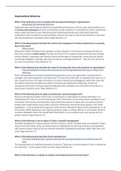Exam (elaborations)
Organizational Behavior Exam Questions and Answers
- Course
- Institution
- Book
All the questions and answers for the course Organizational Behavior 1. Chapters 2, 3, 4, 5, 6, 7, 9, 10. First-year Hotel Management course.
[Show more]




